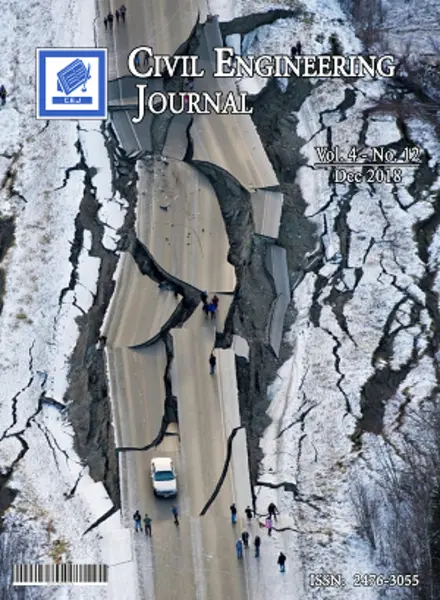-
risks of solely relying on vs30 in ground motion response studies
جزئیات بیشتر مقاله- تاریخ ارائه: 1400/08/01
- تاریخ انتشار در تی پی بین: 1400/08/01
- تعداد بازدید: 230
- تعداد پرسش و پاسخ ها: 0
- شماره تماس ژورنال: 982188779475ext.258
the average shear wave velocity of the uppermost 30 m of earth (vs30) is widely used in seismic geotechnical engineering and soil-structure interaction studies. in this regard, any given subsurface profile is assigned to a specific site class according to its average shear wave velocity. however, in a real-world scenario, entirely different velocity models could be considered in the same class type due to their identical average velocities. the objective of the present study is to underline some of the risks associated with solely using vs30 as a classification tool. to do so, three imaginary soil profiles that are quite different in nature, but all with the same average vs were considered and were subjected to the same earthquake excitation. seismic records acquired at the ground surface demonstrated that the three sites have different ground motion amplifications. then, the different ground responses were used to excite a five-story structure. results confirmed that even sites from the same class can indeed exhibit different responses under identical seismic excitations. our results demonstrated that caution should be practiced when large-contrast velocity models are involved as such profiles are prone to pronounced ground motion amplification. this study, which serves as link between soil dynamics and structural dynamics, warns practitioners about the risks associated with oversimplifying the subsurface profile. such oversimplifications can potentially undermine the safety of existing or future structures.
حوزه های تحت پوشش ژورنال
مقالات جدیدترین رویدادها
-
استفاده از تحلیل اهمیت-عملکرد در ارائه الگوی مدیریت خلاقیت سازمانی و ارائه راهکار جهت بهبود
-
بررسی تاثیر ارزش وجوه نقد مازاد بر ساختار سرمایه شرکت های پذیرفته شده در بورس اوراق بهادار تهران
-
بررسی تأثیر سطح افشای ریسک بر قرارداد بدهی شرکت های پذیرفته شده در بورس اوراق بهادار تهران
-
بررسی تأثیر رتبه بندی اعتباری مبتنی بر مدل امتیاز بازار نوظهور بر نقد شوندگی سهام با تأکید بر خصوصی سازی شرکت ها
-
تأثیر آمیخته بازاریابی پوشاک ایرانی بر تصویر ذهنی مشتری پوشاک ایرانی (هاکوپیان)
-
مشخصات جریان ترافیک و ماهیت شناخت آن
-
بررسی پراکندگی و تراکم و قدمت اشکفت ها و معدن ها و مقبره های دستکند به ثبت رسیده در سازمان میراث فرهنگی ایران با استفاده از سامانه اطلاعات جغرافیایی
-
ارائه ی راهکارهای لازم برای مدیریت استراتژیک جوامع چند قومیتی بر اساس سیستم های چندمتغیره و دکوپله سازی آن ها
-
تاثیر بتن خود متراکم حاوی نانو سیلیس و متاکائولن در مقاومت فشاری محیط معمولی
-
کاربرد خوشه بندی فازی در تحلیل پروتئین های مرتبط با سرطان های مری، معده و کلون بر اساس تشابهات تفسیر هستی شناسی ژنی
مقالات جدیدترین ژورنال ها
-
مدیریت و بررسی افسردگی دانش آموزان دختر مقطع متوسطه دوم در دروان کرونا در شهرستان دزفول
-
مدیریت و بررسی خرد سیاسی در اندیشه ی فردوسی در ادب ایران
-
واکاوی و مدیریت توصیفی قلمدان(جاکلیدی)ضریح در موزه آستان قدس رضوی
-
بررسی تاثیر خلاقیت، دانش و انگیزه کارکنان بر پیشنهادات نوآورانه کارکنان ( مورد مطالعه: هتل های 3 و 4 ستاره استان کرمان)
-
بررسی تاثیر کیفیت سیستم های اطلاعاتی بر تصمیم گیری موفق در شرکتهای تولیدی استان اصفهان (مورد مطالعه: مدیران شرکتهای تولیدی استان اصفهان)
-
بررسی تاثیر آمیخته های بازاریابی سبز بر وفاداری مشتری در شرکتهای کوچک و متوسط محصولات غذایی سبز
-
امکان مطالبه و جبران غرامت و آسیب های جانی مالی نفتکش سانچی بر مبنای حقوق بین الملل
-
بررسی نقش فاکتورهای انگیزشی بر توانمندی کارکنان
-
معیارهای دموکراتیک در دنیای مدرن و اسلام در انتخابات منصفانه
-
comprehensive review on gas migration and preventative strategies through well cementing


سوال خود را در مورد این مقاله مطرح نمایید :